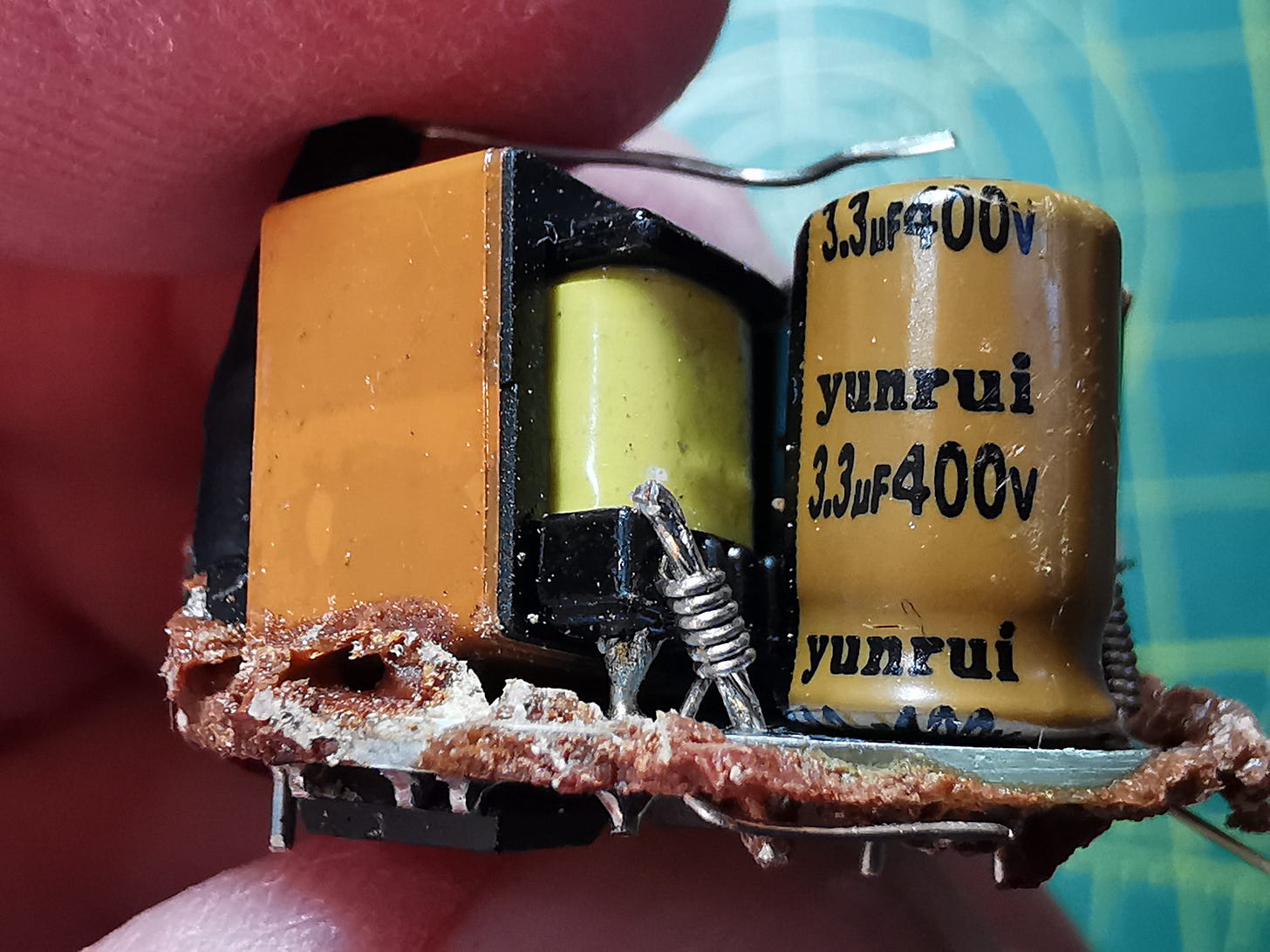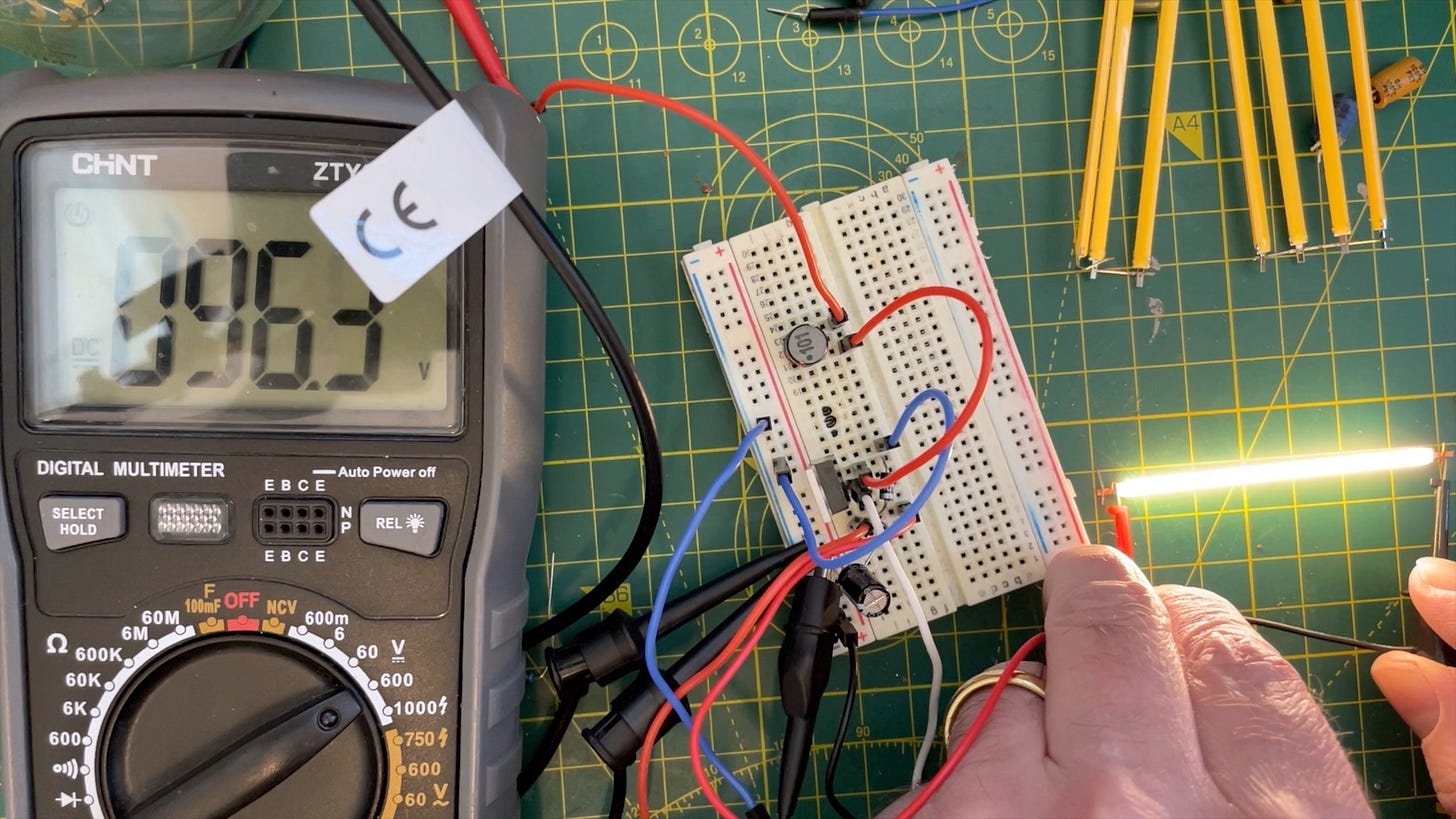What's wrong with my lightbulbs?
These lightbulbs appear to be rubbish - all of them have failed or are failing...
You can view my troubleshooting efforts in this video - or read below if you prefer.
The problem
We've had a slightly annoying epidemic of light bulb failures in the house. Of the four bulbs we purchased, one is still working, one is on its way out, and two are completely dead.
The slowly failing one is not happy at all.
Especially when you contrast it with the one that is working:
I wouldn’t be that upset, bulbs do die, but these were not exactly cheap, and I would expect them to last more than a couple of years.
Feeling hot in here?
One thing I noticed when I swapped out the one working bulb was that it seemed to be getting quite hot around the base. Looking at it with my IR camera, the base appeared to be reaching around 50℃. That’s not crazy hot, but it does suggest it’s probably quite warm inside.
It has been pointed out to me that I should have wrapped the metal base in black tape, as it’s difficult to get a good reading off the metal. But the plastic is quite warm.
What’s inside the bulb?
It was a bit of a mission to take apart the bulb. You need to unpeel the outer metal casing, snap off lots of plastic, and remove some weird brown glue-like stuff.
But once you’ve done that, you end up with this PCB.
The IC on the left is a bridge rectifier—I tested this with my multimeter, and it’s perfectly fine. The black component labeled D1 is a diode, and that also checks out. The other IC is a WS90561, an LED driver IC. Looking at the datasheet, we have this schematic:
And our components seem to match up with it pretty well. My suspicions were that the capacitors were failing—this would be the logical assumption, given that they are getting cooked all the time.
So, I desoldered these components and checked them with my LCR meter.
Unfortunately, they all checked out okay—within 10% of their marked values. No issues at all!
Super smashing
I bit the bullet and smashed the bulb to extract the filaments. Annoyingly, this was the only way to remove them. It’s quite interesting—the LEDs are wired up with the following configuration: there are two sets of parallel LEDs.
The filaments need quite a high voltage to drive them, so I knocked up a very quick and dirty high-voltage power supply.
This is where things get quite interesting. One set of filaments worked completely fine—the other set was completely dead.
What are my conclusions?
All four LED strips on one side were completely dead, which is interesting. My conclusion is that one of the strips went open circuit.
This meant that the current intended for this strip was now going through the other three strips. This stressed them more, causing another to fail, which further stressed the remaining two strips. We ended up with a cascading failure across the four strips, and once they all went open circuit, the bulb stopped working completely.
Why did one of the strips go open circuit? This could be due to one of two things:
They were already being driven too hard - a common problem.
Stress from the high temperatures and the bulbs being turned on and off broke the bonding wires of one of the LEDs.
Either way, all the bulbs slowly failing is pretty disappointing!















Ah yes conspiracy theory, or not, the dreaded 'designed obsolescence'! Just look to all that care taken in the circuitry only to be squandered with the implementation of the filaments. Many decades ago I was on an undergraduate engineering exchange at Philips gloeilamp fabrieken Eindhoven my project was to research accelerated stress testing of H4 bulbs to replace the mass quarantine of bulbs for months required to weed out the failed that had degassed. The aim was to incorporate the testing into the production line no mean feat as they spilled off the line as fast as a machine gun sprays bullets.
Thank you Chris for walking where I fear to tread. I thought these LED filament bulbs were going to be my saviour from the horrible buzzy Compact Fluorescent UV emitting horrors that never seemed to last or light as promised. I'm sure my old incandescent lasted longer. So embraced LED filament, for their immediate quality lighting for my ageing eyes, even at the cost I mean they're LED bound to last right. But no I've got one now who happily periodically flicks off and on, initially thought I hadn't engaged the bayonet properly because didn't feel fully engaged when swapping with a known good from another room. But definitely failing. Didn't have much joy from the conventional LED units either with early failures from OSRAM and LAP should have sent them back as died early. Now where did I put my Carbide?